Elevated levels of circulating interleukin-18 in human immunodeficiency virus-infected individuals: role of peripheral blood mononuclear cells and implications for AIDS pathogenesis
- PMID: 12438570
- PMCID: PMC136707
- DOI: 10.1128/jvi.76.24.12448-12456.2002
Elevated levels of circulating interleukin-18 in human immunodeficiency virus-infected individuals: role of peripheral blood mononuclear cells and implications for AIDS pathogenesis
Abstract
Originally identified as the gamma interferon-inducing factor, interleukin-18 (IL-18) was rediscovered as a proinflammatory cytokine related to the IL-1 family of cytokines that plays an important role in both innate and adaptive immune responses against viruses and intracellular pathogens. Despite its importance in inducing and regulating immune responses, relatively little is known about its production in HIV infection. We report here significantly (P < 0.05) elevated levels of this cytokine in the sera of human immunodeficiency virus (HIV)-infected/AIDS patients compared to those of HIV-seronegative healthy persons. Surprisingly, the peripheral blood mononuclear cells (PBMC) from HIV-infected/AIDS patients were compromised in the ability to upregulate IL-18 gene expression and produce this cytokine with and without lipopolysaccharide (LPS) stimulation. A significant positive correlation (P < 0.05) existed between the concentration of IL-18 in serum and its production from PBMC of HIV-seronegative healthy individuals but not those of HIV-infected/AIDS patients. Furthermore, the patients' PBMC expressed relatively reduced levels of activated caspase-1 constitutively as well as in response to LPS stimulation. Our data suggest the involvement of transforming growth factor beta (TGF-beta) in suppressing IL-18 production from the patients' PBMC for the following reasons. (i) In in vitro studies it suppressed the production of IL-18 from PBMC. (ii) Its levels were significantly higher in the plasma of patients compared to that of control subjects. (iii) A significant negative correlation existed between the concentrations of TGF-beta in plasma and of IL-18 in serum of the patients. The elevated levels of IL-18 in the serum of HIV-infected individuals may contribute to AIDS pathogenesis, whereas its compromised production from their PBMC in response to stimuli may reduce their innate defense to opportunistic intracellular pathogens.
Figures

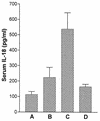


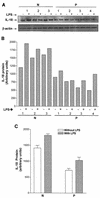
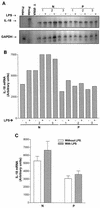

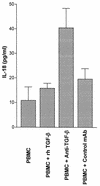
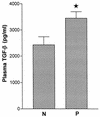
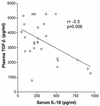
Similar articles
-
Mannoprotein-induced anti-U937 cell cytotoxicity in peripheral blood mononuclear cells from uninfected or HIV-infected subjects: role of interferon-gamma and tumor necrosis factor-alpha.Cell Immunol. 1993 Dec;152(2):530-43. doi: 10.1006/cimm.1993.1310. Cell Immunol. 1993. PMID: 8258154
-
Interleukin-18: a proinflammatory cytokine in HIV-1 infection.Curr HIV Res. 2006 Oct;4(4):423-30. doi: 10.2174/157016206778559993. Curr HIV Res. 2006. PMID: 17073617 Review.
-
Interleukin 18 and interleukin 1beta production is decreased in HIV type 1-seropositive hemophiliacs but not in HIV type 1-seropositive nonhemophiliacs.AIDS Res Hum Retroviruses. 2000 Mar 1;16(4):345-53. doi: 10.1089/088922200309223. AIDS Res Hum Retroviruses. 2000. PMID: 10716372
-
Cytokine gene expression occurs more rapidly in stimulated peripheral blood mononuclear cells from human immunodeficiency virus-infected persons.Clin Diagn Lab Immunol. 2000 Sep;7(5):769-73. doi: 10.1128/CDLI.7.5.769-773.2000. Clin Diagn Lab Immunol. 2000. PMID: 10973452 Free PMC article.
-
Induction of lymphomonocyte activation by HIV-1 glycoprotein gp120. Possible role in AIDS pathogenesis.J Biol Regul Homeost Agents. 1996 Oct-Dec;10(4):83-91. J Biol Regul Homeost Agents. 1996. PMID: 9604776 Review.
Cited by
-
Proliferative activity of extracellular HIV-1 Tat protein in human epithelial cells: expression profile of pathogenetically relevant genes.BMC Microbiol. 2005 Apr 27;5:20. doi: 10.1186/1471-2180-5-20. BMC Microbiol. 2005. PMID: 15857508 Free PMC article.
-
Effects of human immunodeficiency virus on the erythrocyte and megakaryocyte lineages.World J Virol. 2013 May 12;2(2):91-101. doi: 10.5501/wjv.v2.i2.91. World J Virol. 2013. PMID: 24175233 Free PMC article. Review.
-
Potential role of interleukin-18 in the immunopathogenesis of AIDS: involvement in fratricidal killing of NK cells.J Virol. 2009 Jun;83(12):5999-6010. doi: 10.1128/JVI.02350-08. Epub 2009 Apr 1. J Virol. 2009. PMID: 19339355 Free PMC article.
-
Diminished Peripheral CD29hi Cytotoxic CD4+ T Cells Are Associated With Deleterious Effects During SIV Infection.Front Immunol. 2021 Oct 13;12:734871. doi: 10.3389/fimmu.2021.734871. eCollection 2021. Front Immunol. 2021. PMID: 34721397 Free PMC article.
-
Dynamics of Transforming Growth Factor (TGF)-β Superfamily Cytokine Induction During HIV-1 Infection Are Distinct From Other Innate Cytokines.Front Immunol. 2020 Nov 24;11:596841. doi: 10.3389/fimmu.2020.596841. eCollection 2020. Front Immunol. 2020. PMID: 33329587 Free PMC article.
References
-
- Ahmad, A., R. Ahmad, E. Toma, R. Morisset, and J. Menezes. 2000. Impaired induction of IL-15 in response to herpes simplex virus type 1 infection in peripheral blood mononuclear cells of HIV-infected patients. AIDS 14:744-746. - PubMed
-
- Ahmad, R., L. Knafo, J. Xu, S. T. Sindhu, J. Menezes, and A. Ahmad. 2000. Thrombin induces apoptosis in human tumor cells. Int. J. Cancer 87:707-715. - PubMed
-
- Akira, S. 2000. The role of IL-18 in innate immunity. Curr. Opin. Immunol. 12:59-63. - PubMed
Publication types
MeSH terms
Substances
LinkOut - more resources
Full Text Sources
Other Literature Sources
Medical
Miscellaneous

